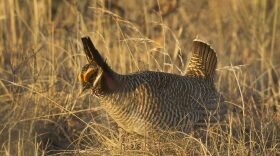As Colorado embarks on an effort to reintroduce gray wolves, two competing packs are starting to form.
One wants to run, and the other wants to walk.
Gov. Jared Polis is leading the pack wanting to speed up the process, saying wolves “take care of themselves” and will be easier to release into the landscape than other animals Colorado has already brought back, including the Canada lynx and the black-footed ferret.
Polis says he has already lined up the first batch.
“I talked to the governor of Wyoming. They're happy to send us some wolves when we're ready,” he said last month. “I think other states are as well. So that's the law of Colorado. A clear directive from the voters. We’re ready to do it.”
Voters approved a plan requiring the state to reintroduce wolves before the end of 2023.
Polis is urging the Colorado Parks and Wildlife Commission to beat that deadline and get them on the ground next year.
“You don’t want to be up against a deadline in three years,” he said.
Supporters of the fast-track approach also are concerned they have a limited amount of time before the entire process could be taken out of Colorado’s hands.
The Trump administration removed wolves from the federal endangered species list right before the election.
Wolf advocate Rob Edward, who led the group supporting Colorado’s reintroduction ballot measure, said it was a mistake to delist the animal. But at the same time, he says the move has a temporary benefit for Colorado.
“As irony likes to have it, sometimes that actually presents a window of opportunity for Colorado to get on with the job of wolf recovery without the burden of having to go through a lot of federal hoops,” he said.
But environmentalists are suing to reverse the delisting. And now the Biden administration is reviewing the issue – all of which could complicate things in Colorado by sending final decisions back to Washington, D.C.
Meanwhile, Polis’ howls to speed things up are not sitting well with ranchers on Colorado’s Western Slope.
‘Don’t rush’
Terry Fankhauser, executive vice president of the Colorado Cattleman’s Association, says calls to speed up the process are “irresponsible.”
“It sends a very clear message of non-concern and really not caring about rural Colorado, specifically western Colorado,” he said.
He and other ranchers are not planning any lawsuits aimed at stopping the will of voters, who were mostly from the Front Range. But he says it took other states, including Wyoming, four years to plan for the return of wolves.
“It’s going to take all of the time we’ve been given,” he said, adding that the state needs to decide how ranchers who lose livestock to wolves will be compensated.
But Edward, of the Rocky Mountain Wolf Action Fund, says wolf reintroduction is not “rocket science.”
He believes Colorado can use the experiences of other states as an example to save time.
“We know how to locate and capture wolves,” he said. “We know the basic parameters of the kinds of traits that we want in these wolves, specifically with regard to their prey, et cetera. But beyond that, it's just a matter of putting that plan down on paper, basing it on the most up to date science, and giving the public a chance to review and comment and hopefully make it better.”
Edward says researchers have already done much of the work. As an example, he points to a 16-year-old map outlining the four most ideal places to release wolves in Colorado.
It includes one spot in the Flat Tops Wilderness Area.
While Edward looks at the map and sees opportunity, Fankhauser sees potential conflicts.
“It’s a tough one because obviously if you live in one of these areas and you’re a beef producer, you’re concerned,” he said. “You’re concerned about these animals being listed on a map and saying these things are going to live there.”
A complicated picture
As debate over reintroduction continues to go back and forth, the state board overseeing the plan appears to be siding with Fankhauser.
Only one of its 11 members is advocating for the governor’s fast track. And most – including Charles Garcia – think they should wait.
“I’m not in any rush to get this done again,” he said. “I think we need to do it right. Take our time.”
The picture could change this summer. Polis has an opportunity to influence things in July when he makes two new appointments to the state wildlife board. And the new Biden administration is reviewing the previous administration’s decision to delist the wolves.
Lisa Reynolds, an attorney advising the wildlife board, says it’s hard to read all the tea leaves in Washington, D.C. right now.
“I will tell you that U.S. Fish and Wildlife has been supporting a nationwide delisting for years,” she said. “So, there may not be agreement between the new administration at the top and with their staff.”
And it could take years to resolve the lawsuits and reviews. So, that puts advocates like Edward in the awkward position of advocating for the wolves to be relisted at the same time he urges Colorado to move forward before it actually happens.
In the meantime, the wolves are not waiting for politics to get settled in Colorado, or D.C.
Colorado Parks and Wildlife officials announced this month they successfully collared a wolf that was spotted in North Park in Jackson County.
The news comes months after other wolves were spotted in the northwest part of the state.

Copyright 2021 KUNC








